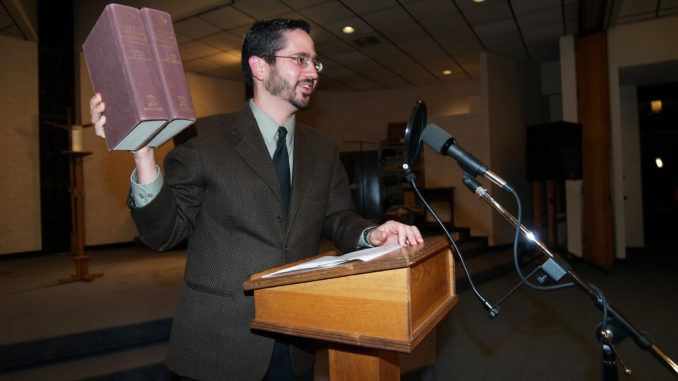
They’re forgeries
This is the second of a three-part series on the Origin of the Bible: Human Invention or Divine Intervention?” by Dr. Brant Pitre. Dr. Pitre is a biblical scholar of international acclaim. For background information or CD’s of his bible studies, visit www.brantpitre.com
He is one of the most reviled men in history. But was Judas only obeying his master’s wishes when he betrayed Jesus with a kiss?
That’s what a newly revealed ancient Christian text says.
After being lost for nearly 1,700 years, the Gospel of Judas was recently restored, authenticated, and translated.
The Coptic, or Egyptian Christian, manuscripts were unveiled at National Geographic Society headquarters in Washington, D.C. And some biblical scholars are calling the Gospel of Judas the most significant archaeological discovery in 60 years.
The only known surviving copy of the gospel was found in a codex, or ancient book, that dates back to the third or fourth century A.D.
The newly revealed gospel document, written in Coptic script, is believed to be a translation of the original, a Greek text recorded by an early Christian sect some time before A.D. 180.
The Bible’s New Testament Gospels – Matthew, Mark, Luke, and John – depict Judas Iscariot, one of the Twelve Apostles of Jesus, as a traitor. In biblical accounts, Judas gives up Christ to his opponents, who later crucify him.
The Gospel of Judas, however, portrays him as acting at Jesus’ request.
“This Lost Gospel, providing information on Judas Iscariot – considered for 20 centuries and by hundreds of millions of believers as an antichrist of the worst kind – bears witness to something completely different from what was said [about Judas] in the Bible,” said Rodolphe Kasser, a clergyman and former professor in the Faculty of Arts at the University of Geneva, in Switzerland.
The recent discovery of this “Lost Gospel” has caused a stir in the media, as can be seen in the above quotation, excerpted from National Geographic News.
But this and other “Lost Gospels” weren’t really lost. We knew about these gospels for centuries, explained Dr. Brant Pitre at Holy Family Community Center in Luling.
The expert talked about dozens of writings that were forged in the name of the Apostles in the between 200 and 500 A.D.
These included: The Gospel of Peter, The Gospel of Thomas, The Gospel of Judas, The Gospel of Mary Magdalene, The Acts of Paul and Thecla and the Apocalypse of Peter.
“These Gospels were written over 100 years after the apostles were dead. It’s kind of hard to write when you’re six feet under,” said Pitre.
The earliest Christian leaders, the Apostolic Fathers who were ordained by the Apostles, knew about these gospels and denounced them as false.
Apostolic Father St. Irenaeus denounced “the Gospel of Judas” in 180 A.D. (Against Heresies 1.31.1;ANF1.358) and said it was a fictitious history written by heretics called Cainites. “The Cainites traced themselves to Cain (who murdered Able). That should tell you something,” said Pitre.
It’s interesting to note, says Pitre, that there are thousands of credible published writings of these earliest disciples of the Apostles, but we never hear about them in the media.
Heretics lived back then just like today. “Why do these false Gospels from ancient Christian heretics get so much attention?” he asks.
Another Gospel that has received a lot of press is the “Gospel of Thomas” that was written around 300 A.D. by the Gnostics, who denied the goodness of Creation.
Here is a passage called the “Infancy Story of Thomas” (from The Gospel of Thomas forged by the Gnostics):
“When this boy Jesus was five years old he was playing at the ford of a brook, and he gathered together into pools the water that flowed by, and made it at once clean … but the son of Annas the scribe was standing there with Joseph; and he took a branch of a willow and dispersed the water which Jesus had gathered together.
“When Jesus saw what he had done he was enraged and said to him: ‘You insolent, godless dunderhead, what harm did the pools and the water do to you?
“‘See, now you shall also wither like a tree and shall bear neither leaves nor root nor fruit.’ And immediately the lad withered up completely…
“After this, again (Jesus) went through the village, and a lad ran and knocked against his shoulder. Jesus was exasperated and said to him: ‘You shall not go further on your way,’ and the child immediately fell down and died. (Schneemelcher, New Testament Apocrypha, 1:444).
“I actually think this was written to mock Christians,” said Pitre.
The true Gospels of Matthew, Mark, Luke and John were written in close proximity of the event, only 20-50 years after the Crucifixion, were based on eyewitness testimony and have in existence reliable manuscripts. These Gospels are also quoted thousands of times by the earliest Church Fathers.
“They took the same precautions back then like they do when they write history books today,” said Pitre. The lost Gospels were lost for a reason.
Next week’s Bible study: What does Divine Authority Mean? Why are there different Christian Bibles?

Be the first to comment